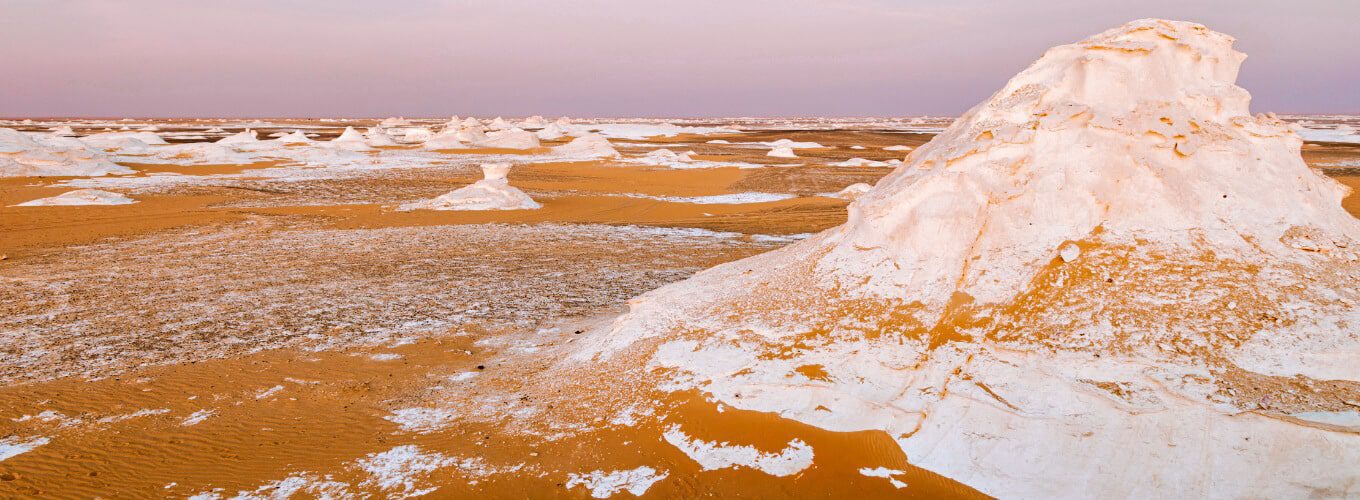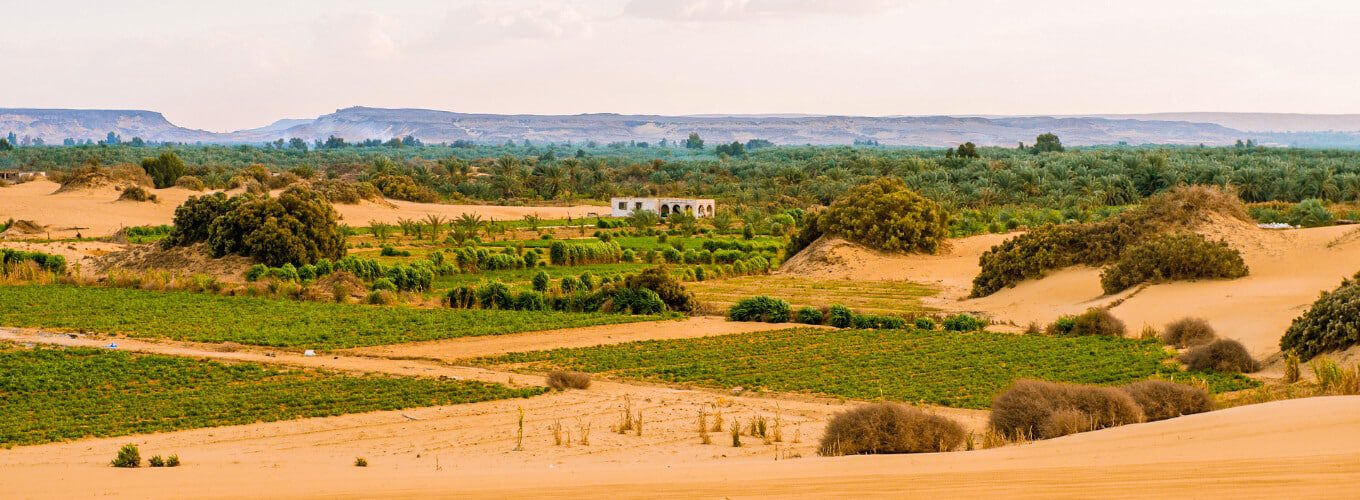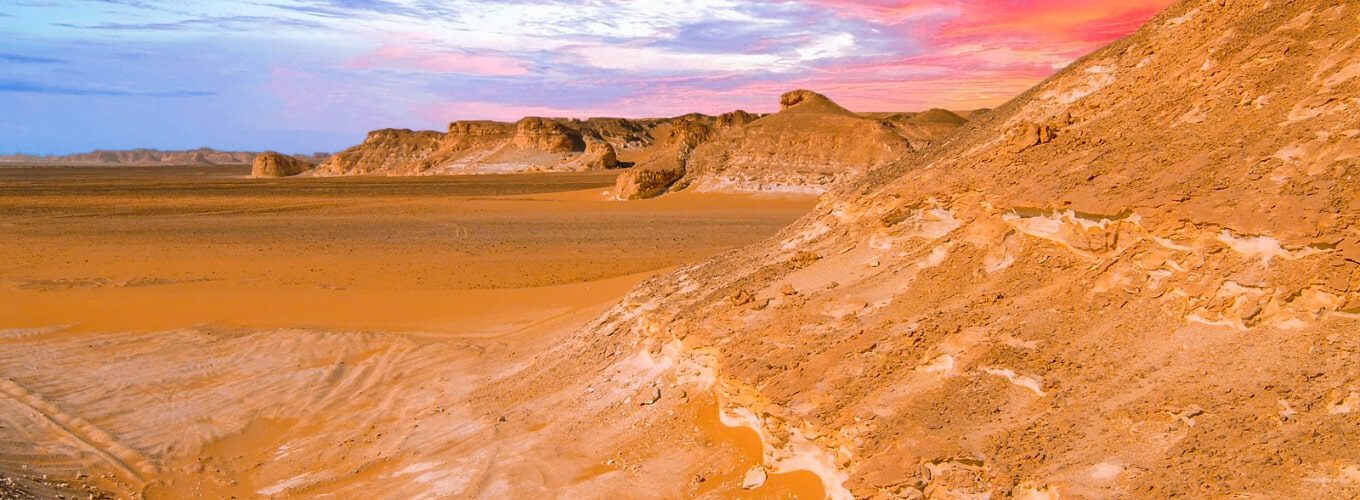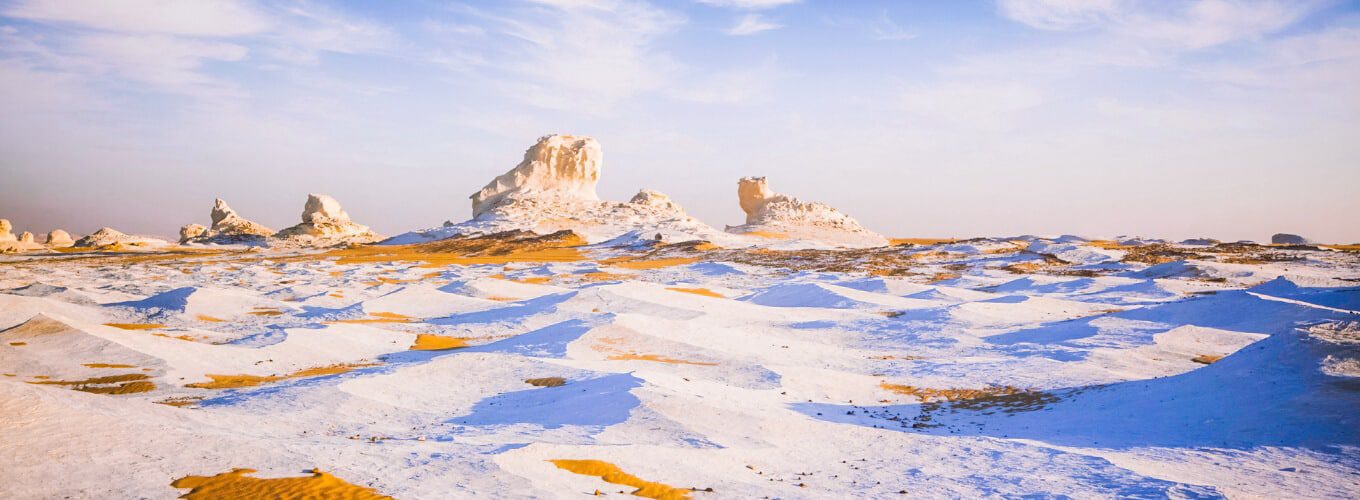The White Desert National Park (Sahara el-Beida) stretches between the two oases, Farafra and Bahariya. This Desert is one of the most miraculous places in Africa. Wind and rain have worked together to cut the limestone, rich in fossils and shines white in the sun, into various shapes. Some are like giant mushrooms in the sunlit Desert, others like mighty rock castles or other bizarre forms. The White Desert is most impressive in the hours of the rising and setting sun, but particularly in the light of the full moon.
The White Desert National Park in Egypt is said to be one of the most visited popular attractions for adventure tourism due to the unusual and diverse rock formations in its brilliant white surroundings.
For a good reason, the White Desert is rightfully Egypt’s best-known desert destination. The number of otherworldly and beautiful rock formations carved by the wind into giant mushrooms or pebbles is unmatched in any desert in the world. Farafra is closer than Bahariya to this 300-kilometer protectorate; however, it offers a more limited choice of excursions and safaris. However, it remains the perfect starting point for a night’s journey into endless whiteness.
Most people who visit the National Park are enchanted by the white sands and the white sand rock formations that are unique compared to the more traditional shades of red and orange sands that cover the rest of the Sahara desert.

Where is the White Desert National Park in Egypt?
The White Desert is located in the western part of Egypt, specifically in the Farafra depression, one of the five significant depressions in the Western Desert. It is approximately 45 kilometers north of Farafra Oasis and about 500 kilometers southwest of Cairo. The White Desert is famous for its unique white rock formations and is a popular tourist destination in Egypt.
Indulge in opulence with our Luxury Nile Cruises. Take action and reserve your Trip for a truly lavish experience.
Visiting the White Desert and What to See.

A hike through this unusual landscape offers complete solitude. On the way to the Bahariyya Oasis, about 20 km/12 miles northeast of Qasr elFarafra, the route crosses part of the White Desert. However, the experience is much more impressive if you go off-road. This requires an experienced driver and a four-wheel drive vehicle, which can be easily arranged from Farafra and Bahariyya.
The fantastic shapes of the Farafra White Desert result from millions of years of erosion of this chalk by wind and sand blown from the Great Sand Sea.
In many places, the accumulation of white sand looks like snow that has frozen the Desert. These white quartz crystals have created several unique picturesque rock shapes. The pinnacle white rock formation is known as Crystal Mountain, and it is entirely made of glass and has a hole in the middle.
In addition to protecting the white sands and unique rock formations of the Sahara desert, the park also covers a variety of wildlife. Some of the most popular species include Barbary sheep, fennec fox, Dorcas gazelle, jackal, red fox, Rhmim’s gazelle, Ruppell’s fox, and sand cats.
Begin your journey of love with our enchanting Egypt Honeymoon Packages. Reserve your romantic getaway now!
The Crystal Mountain

Crystal Mountain is also called Crystal Rock, the most iconic rock formation in the national park. Although it is not as high or as big as the Delicate Arch in Arches National Park, it gives you a similar feeling. The good news is that this prominent attraction is easily accessible just off the main road. It is about 15 miles (24 km) north of Naqb As Sillim.
The Great Sea of Sand

The great sea of Sand is a part of the Sahara desert between Egypt and Libya. This portion of the Desert covers an area of 27,799.36 square miles (72,000 square kilometers). It is famous for the abundant undulating sea of dunes that covers approximately three-quarters of the site.
The Great Sea of Sand extends well beyond the national park’s borders, which only serves as an introduction to this magnificent presentation of nature. However, there are opportunities to discover and explore the White Desert as part of an exploratory adventure that delves deeper into the Great Sand Sea, providing a fuller discovery of the splendor of the Sarah Desert.
Immerse yourself in Egypt’s rich culture with our Egypt Cultural Tours. Don’t wait. Book your cultural exploration today!
Bahariya Oasis

The Bahariyya Oasis, a roughly oval depression, covers an area of about 94 km/58 mi long and 40 km/25 mi wide, but only about a fifth of it is used for agriculture. Small hamlets are found among orchards and groves of date palms and olive trees, the population’s primary income source.
The northernmost of the four great oases in the so-called New Valley is about 330 km / 205 miles southwest of Cairo and can be easily reached via a paved road. The other connections are to the south, to an oasis called Farafra, 180 km / 110 miles away, and for some time also to the Siwa oasis.
The largest settlement is Bawiti, which – together with the neighboring settlement El-Qasr – has about 25,000 inhabitants.
Explore the treasures of Cairo with our Day Tours in Cairo. Reserve your spot for an exciting day of exploration!
Farfara Oasis

A fantastic sea of shimmering limestone rocks surrounds Farafra, the smallest of the four oases in the New Valley in the Libyan Desert. In the former Oasis core region, concentrated in the main settlement of Qasr el-Farafra, some 2,000 people live on dates, citrus fruits, and olives; their oil is world-famous.
Farafra is located about 180 km / 110 miles southwest of Bahariyya Oasis and 210 km / 130 miles northwest of Dakhla Oasis. Even though nomadic tribes visited Farafra since Paleolithic times, and it was also an important stopping place on the caravan route between the oases in Pharaonic times, there are no ancient remains except for undecorated rock tombs. However, walks through the oasis gardens offer rest and pleasure.
What to take on a trip to Egypt’s black and white Desert?
- Hiking shoes
- Long hiking pants
- Warm clothing (jacket, hat, gloves)
- Sleeping bag (in case your tour operator does not provide it)
- Headlamp
- Toilet paper
- Power bank (there is no only place with electricity during the whole tour)
- Water … lots of water
- Snacks (energy bars, fruits, chocolates)


